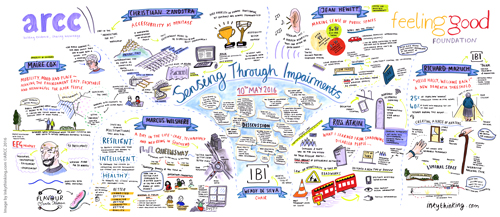Sensing through impairments
May 2016, IBI Group, London
Our feeling good in public space series has been unravelling the impacts of design on a physiological and psychological level, irrespective of age, gender, class or bodily ability. Good design does not discriminate, and yet the physical environment is full of poor design that does.
This event focuses on research and case studies that tackle how to design an environment to empower people who have lost a sense. This includes some of the less well-known sensory functions which aid our bodily perception of space, as well as the more familiar senses. Talks will cover:
- How do we make public spaces into lifetime spaces that work for all ages and abilities in a changing climate?
- Should design thinking go beyond just the use of visual warning signs and tactile surfaces at street crossings?
- How can we harness new technologies to aid our senses and use of public spaces in a changing environment?
Chair
Wendy De Silva, IBI Group
Speakers
Mobility, mood and place – making the environment easy, enjoyable and meaningful for older people
Máire Cox, University of Edinburgh
Going outdoors is essential for maintaining health and wellbeing into later life, but many older people find it becomes less easy, enjoyable and meaningful as they age. Mobility, Mood and Place (MMP) is a £1.6m research project exploring how places can be designed collaboratively to improve older people’s experience of pedestrian mobility. Funded by the EPSRC through the Lifelong Health and Wellbeing Cross-Council Programme, the project builds on evidence that how we experience environments influences our mood and, in turn, our willingness to be active. As analysis begins on two years of data collection, this talk will look at the project’s range of innovative research methods, including co-design with older people, mobile neural imaging, and the use of lifecourse data to measure the influence of local environments over time.
“Hello Holly, welcome back!” A new dementia threshold
Richard Mazuch, IBI Group
With an ever increasing Dementia population more pressure is being exerted on the National Health and Social Services. These patients have many problems with wayfinding, legibility, orientation, and familiarity. Statistics tell us:
- 25% of people who ‘wander’ experience serious or fatal injury (Rader, 1987)
- 40% of people with dementia get lost at some point – 5% of people with dementia get lost repeatedly (McShane et al., 1998)
Misplaced patients do miss treatment, medication and care, resulting in feelings of fear, abandonment, anxiety, aggression, stress, and increased morbidity which in turn results in spiraling NHS/Caregiver costs.
Within this developing scenario, a group of designers developed multiple solutions incorporated in one innovative and unique design, integrated resolution… The ‘Dementia Threshold’. This provides a complete, rapid construct, entrance module for individual patient bedrooms. It incorporates extensive assistive technology and details throughout. The many components include an interactive stable door, pressure mats, video door entry system, wristband activated doors, skirting/architrave lighting, welcome voice recording interactive, personalised cabinet, smell emitters, bogus caller alarm, ergonomic friendly ironmongery, heated seating, activated sequential lighting to destination, captive walking aid features, etc.
The presentation will then allow Holly to enter the public realm seeing how assistive design and technology can support her navigation beyond the home and back.
What I learned from shadowing disabled people…
Ross Atkin, Ross Atkin Associates
I’ll Summarise some key findings from seven years of shadowing disabled people as they navigate public space, and show how this influenced two design and technology projects; Sight Line and Responsive Street Furniture.
A day in the life – care, technology and wellbeing in Southend
Marcus Wilshere, IBI Group
Marcus will outline a case study of a process that started with identifying the demographic profile of a community including elderly, people with physical impairments and people with mental health issues, and how IBI group developed approaches across design and technology in answer to the question ‘How can we improve people’s quality of life’? Lived experience has informed the proposals for the area’s regeneration, and we will share how with you.
Accessibility as heritage
Christiaan Zandstra
My study focuses on accessibility as an architectural challenge from a heritage perspective. What do we mean by heritage? What we inherit from the past, but also that what we want to pass on to future generations. We are faced with an emancipation of disabled people and a challenge to create equality in the design of the built environment. The solutions we find and the inclusive culture we create will be our tangible and intangible heritage to the future. Accessibility highlights the relationship we – all of us – have with our built environment. Human function is based on three core activities, from sensing to moving and interpreting. These activities must to be viewed together when assessing the relationship we – diverse as we are – have with our built environment.
Making sense of public spaces
Jean Hewitt, Centre for Accessible Environments (CAE)
Jean will be speaking about hearing loss and balance conditions, and explore how external environments can be challenging for people with sensory impairments or conditions, as well as the often underestimated distress for people with acutely sensitive hearing, (as is often the case for someone with Autism). True community engagement rather than box ticking consultation is the key to achieving a sense of belonging and community attachment but this successful engagement with disabled people requires advance planning and resourcing to cater for a spectrum of additional needs and sadly is often a last minute consideration.








